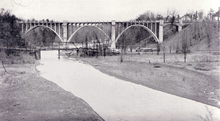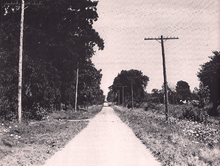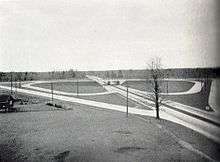The Middle Road
The Middle Road was the name for a historic highway in the Canadian province of Ontario, which served to link the cities of Toronto and Hamilton. The name was used between 1931 and 1939, after which the road became the northern section of the Queen Elizabeth Way. It borrowed the name of Middle Road from a concession road in Toronto Township between 1st Concession South and 2nd Concession South during the early 1800s.
| Middle Road | |||||||
|---|---|---|---|---|---|---|---|
| Queen Street extension | |||||||
| Route information | |||||||
| Maintained by Ontario Department of Highways | |||||||
| Length | 61.6 km (38.3 mi) | ||||||
| History | Constructed 1931–1939[1] renamed the Queen Elizabeth Way | ||||||
| Major junctions | |||||||
| West end | |||||||
| East end | |||||||
| Highway system | |||||||
Roads in Ontario
| |||||||
The Middle Road was initially constructed as a depression relief project, employing 74 men to grade and widen the country lane into a four lane roadway. In 1934, the concept was reworked by Thomas McQuesten and Robert Melville Smith into a divided, limited access freeway, the first such intercity stretch in North America when it was opened in 1939.[Note 1]
The Middle Road provided the blueprint for Highway 401, believed by some to be the most important single factor to the current economy and standard-of-living in Ontario.[2]
Route description
The Middle Road or Commissioners' Road,[3] named so because of its location between what were then the highways (or historic streets) between Toronto and Hamilton, Dundas Street and Lakeshore Road, followed the same path taken by today's Queen Elizabeth Way (QEW), with little exception, beginning at the Humber River and travelling to Bronte Line (where today, the QEW veers south). Since the highway followed a concession road,[4] it was straight for almost its entire length, veering only at Browns Line (Highway 27), the Credit River, and at the Oakville border. At the time of construction, this route was surrounded by farmland, as most of the towns in the area at the time lay along Dundas or Lake Shore, to the north and south respectively. However, the highway spurred rapid development of the surrounding land; it did not take long for farmland to become subdivisions. Middle Road was also a concession created between 1st Concession South and 2nd Concession South during the early 1800s.

Most of the route was paved with concrete.[5] The two roadways were separated by a median varying in width,[Note 2] often filled with trees. Most of the rows of trees along the old country lane were incorporated into the median, and new ones were planted in the gaps, as equal focus was given to functionality as aesthetics.[6] Over most of the bridges, the two roadways converged, undivided. These were, however, a great improvement from the bridges along the old lane, as seen in the picture at left. At Highway 10 (Hurontario Street) was Canada's first cloverleaf interchange,[7] opened in 1937.[8][Note 3]
One of the elements of the Middle Road, to which engineers paid particular attention in future highway design, was controlled access. While the section between the Humber River and Highway 27 was built without allowance for private driveways, and was thus controlled-access, many at-grade intersections existed along the Middle Road west of Highway 27, and many adjoining landowners built driveways to the highway for access, an issue that led to the creation of legislation to allow the designation of a road as 'controlled-access'.[9]
Today, a small remnant of the pre-1930s Middle Road can be found spanning the Etobicoke Creek off of Sherway Drive at the Mississauga and Etobicoke border. The bridge, constructed in 1909, was part of Middle Road until 1932 and served as a farm lane until the section of the Queen Elizabeth Way into Toronto opened in 1940.[10][11] It was the first concrete truss bridge built in Canada. It was designed by Frank Barber and built by Octavius Hicks.[12] The short section was later renamed Sherway Drive.
History

In colonial times, both Lakeshore Road and Dundas Street existed. In Toronto Township (modern Mississauga) the dirt path between concessions one and two was referred to as "the middle road" in 1852.[13] Later in the 19th century Toronto Township council began to ask Etobicoke Township about connecting Middle Road with a road in Etobicoke between the 2nd and 3rd concessions. There were right of way difficulties as the two roads met the Etobicoke River in different places.[14] These discussions continues sporadically in the late the 19th century with York County Council receiving proposals from Peel County Council.[15] Finally in 1909 Middle Road was carried over the Etobicoke River.[16]
The Middle Road was not the first highway between Toronto and Hamilton. In January 1914, a cement road known as the Toronto–Hamilton Highway was proposed.[17] The highway was chosen to run along the macadamized old Lake Shore Road, instead of Dundas Street to the north, because of the numerous hills encountered along Dundas Street, which would have increased the cost of the road without improving accessibility. Middle Road, a dirt lane named because of its position between the two, was not considered since Lake Shore and Dundas were both overcrowded and in need of serious repairs.[18] By November of that year, the proposal was approved,[19] and work began quickly to construct the road known today as Lake Shore Boulevard and Lakeshore Road from Toronto to Hamilton. The road was finished by 1917, 18 feet (5.5 m) in width and nearly 40 mi (64 km) long, becoming the first concrete road in Ontario, as well as one of the longest stretches of concrete road between two cities in the world.[20] The highway became the favourite drive of many motorists, and it quickly became a tradition for many families to drive it every Sunday.[21]

Over the next decade, vehicle usage increased monumentally; as early as 1920 the Lake Shore Road was once again bumper to bumper on weekends.[22] In response, the Department of Highways once again sought out improving another road between Toronto and Hamilton. Middle Road, a continuation of Queen Street west of the Humber River, was chosen to avoid delays on Dundas or Lake Shore. The road was to be more than twice the width of the Lake Shore Road, at 40 ft (12 m), and would carry two lanes of traffic in each direction.[1] Construction on what was then known as the Queen Street Extension between Highway 10 and Highway 27 began in the spring of 1931,[23] and between Highway 27 and the Humber River on November 1, 1931.[24]

Before the highway could be completed, the 1934 provincial elections brought Mitchell Hepburn into office as premier and Thomas McQuesten was appointed the new minister of the Department of Highways.[25] McQuesten in turn appointed Robert Melville Smith as deputy minister. Smith, inspired by the German Autobahns - new "dual-lane divided highways", separated by a depressed grass centre crossing short distances between major cities - modified the design for Ontario roads,[26] and McQuesten ordered that the Middle Road be changed into this new form of highway.[27][28][29] A right-of-way of 132 ft (40 m) was purchased along the Middle Road and construction began to convert the existing sections to a divided highway, as well as on Canada's first cloverleaf interchange at Highway 10.[1]
Thomas McQueston[30]
By the end of 1937, the Middle Road was open between Toronto and Burlington, where it connected with what was first known as the Hamilton – Niagara Falls Highway. It soon came time to name the new highway, and an upcoming visit by King George VI and Queen Elizabeth proved to be the focal point for a dedication ceremony. On June 7, 1939, the two royal family members drove along the highway (which now connected to Niagara Falls) and passed through a light beam nearby the Henley Bridge in St. Catharines. This caused two Union Jacks to swing out, revealing a sign which read The Queen Elizabeth Way.[31]
However, the ceremony only designated the highway between St. Catharines and Niagara Falls. The remainder of the road was known by various names, including the Toronto–Burlington/Hamilton Highway and The New Middle Road Highway. At the formal opening of the highway between Toronto and Niagara Falls on August 23, 1940, the entire length was declared The Queen Elizabeth Way by Thomas McQueston.[31]
References
- Notes
- While the Long Island Parkway and several similar roadways opened in the late twenties and early thirties, these parkways were designed to move traffic in and out of a city's downtown. The Middle Road was designed to provide travel between cities, and opened a year before the Pennsylvania Turnpike, the first U.S. highway to do this.
- Shragge indicates three to ten feet on page 79, consistent with the minimum of one metre given by Stamp on page 20, but far less than the maximum of nine metres.
- Stamp also writes on page 20 that construction on the cloverleaf began in 1937. Shragge also indicates it opened in 1937 on page 81.
- Sources
- Shragge p. 79
- Shragge p. 95 "as geography professor, E.G. Pleva, of the University of Western Ontario stated: ‘Highway 401 is the most important single development changing the social and economic pattern of Ontario. It is still transforming the province's economy and the social, work and spending habits of its people.’"
- http://www.pollard.ca/genealogy/0001text.txt
- Stamp p. 13
- Stamp p. 50
- Stamp p. 24
- Shragge p.81
- Stamp p. 25
- Stamp p.
- Ontario Heritage Bridge Guidelines (PDF) (Report). Ministry of Transportation of Ontario. January 11, 2008. pp. 41–42. Archived from the original (PDF) on July 27, 2011. Retrieved July 26, 2010.
- Cook, Dave. "History of Our Community - Middle Road Bridge". Sherway Homeowners & Recreational Association. Retrieved July 26, 2010.
- Frank Barber (1909). "CONCRETE TRUSS BRIDGE: THE FIRST IN CANADA" (PDF). Canadian Engineer. 17: 567.
- "More Conflagrarion". Toronto Globe. Toronto. 1 Jun 1852. p. 266.
- "Etobicoke Township Council". Toronto Globe. Toronto. 12 Nov 1877. p. 4.
- "Dissection". Toronto Globe. Toronto. 26 Jan 1889. p. 4.
- "New Idea in Bridges". Toronto Globe. Toronto. 28 Oct 1909. p. 13.
- The Toronto World (January 22, 1914). "Toronto–Hamilton Highway Proposed". 34 (12125). p. 14. Retrieved February 9, 2010.
- Shragge p. 55
- The Toronto World (October 26, 1914). "Council Meets Today To Pass Agreement". 34 (12402). p. 3. Retrieved February 9, 2010.
- Shragge p. 55 "...the Toronto-to-Hamilton highway which, when completed in 1917, was both Ontario's first concrete highway and one of the longest such inter-city stretches in the world."
- Shragge, John G. (2007). "Story Archive". Retrieved February 24, 2010.
- Toronto World (June 26, 1920). "Increased Volume of Traffic". 40 (14472). p. 7. Retrieved February 12, 2010.
- Filey, Mike (1994). Toronto sketches 3: the way we were. Dundurn Press. pp. –. ISBN 1-55002-227-X. Retrieved February 10, 2010.
Some Superhighway History.
CS1 maint: extra punctuation (link) - The Gazette (October 16, 1931). "Tenders Called For". 160 (255). Montreal. p. 15. Retrieved February 9, 2010.
- Shragge, John G. (2007). "Highway 401 - The story". Archived from the original on March 28, 2008. Retrieved February 12, 2010.
- Stamp pp. 19–20
- Canadian Press (February 18, 1936). "Hopes to Improve Roads". 165 (42). Montreal: The Gazette. p. 14. Retrieved February 9, 2010.
- English, Bob (March 16, 2006). "Remember that 'little four-lane freeway?'". Toronto: Globe And Mail. Archived from the original on September 30, 2007. Retrieved February 9, 2010.
...the freeway concept was promoted by Hamiltonian Thomas B. McQuesten, then the highway minister. The Queen Elizabeth Way was already under construction, but McQuesten changed it into a dual-lane divided highway, based on Germany's new autobahns.
- Smith pp. 11–12
- "Ontario To Bar All Gas Stands On Speedways". The Gazette. 167 (214). Montreal. September 7, 1938. pp. 1, 19. Retrieved February 12, 2010.
- Filey, Mike (June 6, 2010). "A royal trip around T.O.". The Toronto Sun. Sun Media. p. 37.
|section=ignored (help)
- Bibliography
- Stamp, Robert M. (1987). The Queen Elizabeth Way, Canada's First Superhighway. Boston Mills Press. ISBN 0-919783-84-8.
- Shragge, John; Bagnato, Sharon (1984). From Footpaths to Freeways. Ontario Ministry of Transportation and Communications, Historical Committee. ISBN 0-7743-9388-2.